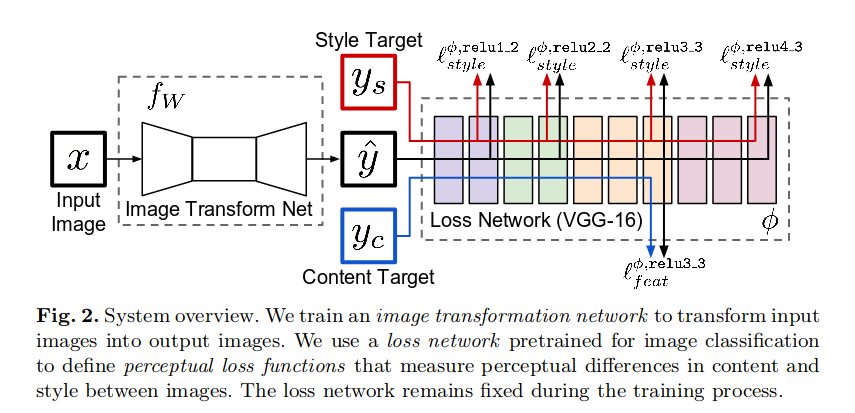
我正在尝试使用keras 内置训练和评估循环中描述的方法复制快速风格迁移论文(见上图)
我在理解如何使用自定义损失类来做到这一点时遇到问题(见下文)。
为了计算损失成分,我需要以下内容:
y_hat,生成的图像得到
(generated_content_features, generated_style_features) = VGG(y_hat)
generated_style_gram = [ utils.gram(value) for value in generated_style_features ]
target_style_gram这是静态的,所以我可以从中获取一次target_style_features并缓存,(_,target_style_features) = VGG(y_s)x,InputImage(同y_cContentTarget)得到(target_content_features, _) = VGG(x)
我发现我正在对损失类中的很多东西进行猴子修补tf.keras.losses.Loss,以便得出这些值并最终执行损失计算。target_content_features对于需要输入图像的情况尤其如此,这是我通过的y_true,但这显然是一种黑客行为
y_pred = generated_image # y_hat from diagram, shape=(b,256,256,3)
y_true = x # hack: access the input image here
lossFn = PerceptualLosses_Loss(VGG, target_style_gram)
loss = lossFn(y_true, y_pred)
class PerceptualLosses_Loss(tf.losses.Loss):
name="PerceptualLosses_Loss"
reduction=tf.keras.losses.Reduction.AUTO
RGB_MEAN_NORMAL_VGG = tf.constant( [0.48501961, 0.45795686, 0.40760392], dtype=tf.float32)
def __init__(self, loss_network, target_style_gram, loss_weights=None):
super(PerceptualLosses_Loss, self).__init__( name=self.name, reduction=self.reduction )
self.target_style_gram = target_style_gram # repeated in y_true
print("PerceptualLosses_Loss init()", type(target_style_gram), type(self.target_style_gram))
self.VGG = loss_network
def call(self, y_true, y_pred):
b,h,w,c = y_pred.shape
#???: y_pred.shape=(None, 256,256,3), need batch dim for utils.gram(value)
generated_batch = tf.reshape(y_pred, (BATCH_SIZE,h,w,c) )
# generated_batch: expecting domain=(+-int), mean centered
generated_batch = tf.nn.tanh(generated_batch) # domain=(-1.,1.), mean centered
# reverse VGG mean_center
generated_batch = tf.add( generated_batch, self.RGB_MEAN_NORMAL_VGG) # domain=(0.,1.)
generated_batch_BGR_centered = tf.keras.applications.vgg19.preprocess_input(generated_batch*255.)/255.
generated_content_features, generated_style_features = self.VGG( generated_batch_BGR_centered, preprocess=False )
generated_style_gram = [ utils.gram(value) for value in generated_style_features ] # list
y_pred = generated_content_features + generated_style_gram
# print("PerceptualLosses_Loss: y_pred, output_shapes=", type(y_pred), [v.shape for v in y_pred])
# PerceptualLosses_Loss: y_pred, output_shapes= [
# TensorShape([4, 16, 16, 512]),
# TensorShape([4, 64, 64]),
# TensorShape([4, 128, 128]),
# TensorShape([4, 256, 256]),
# TensorShape([4, 512, 512]),
# TensorShape([4, 512, 512])
# ]
if tf.is_tensor(y_true):
# print("detect y_true is image", type(y_true), y_true.shape)
x_train = y_true
x_train_BGR_centered = tf.keras.applications.vgg19.preprocess_input(x_train*255.)/255.
target_content_features, _ = self.VGG(x_train_BGR_centered, preprocess=False )
# ???: target_content_features[0].shape=(None, None, None, 512), should be shape=(4, 16, 16, 512)
target_content_features = [tf.reshape(v, generated_content_features[i].shape) for i,v in enumerate(target_content_features)]
elif isinstance(y_true, tuple):
print("detect y_true is tuple(target_content_features + self.target_style_gram)", y_true[0].shape)
target_content_features = y_true[:len(generated_content_features)]
if self.target_style_gram is None:
self.target_style_gram = y_true[len(generated_content_features):]
else:
assert False, "unexpected result for y_true"
# losses = tf.keras.losses.MSE(y_true, y_pred)
def batch_reduce_sum(y_true, y_pred, weight, name):
losses = tf.zeros(BATCH_SIZE)
for a,b in zip(y_true, y_pred):
# batch_reduce_sum()
loss = tf.keras.losses.MSE(a,b)
loss = tf.reduce_sum(loss, axis=[i for i in range(1,len(loss.shape))] )
losses = tf.add(losses, loss)
return tf.multiply(losses, weight, name="{}_loss".format(name)) # shape=(BATCH_SIZE,)
c_loss = batch_reduce_sum(target_content_features, generated_content_features, CONTENT_WEIGHT, 'content_loss')
s_loss = batch_reduce_sum(self.target_style_gram, generated_style_gram, STYLE_WEIGHT, 'style_loss')
return (c_loss, s_loss)
我也尝试在 中预先计算y_true,tf.data.Dataset但是虽然它eager execution在model.fit()
xy_true_Dataset = tf.data.Dataset.from_generator(
xyGenerator_y_true(image_ds, VGG, target_style_gram),
output_types=(tf.float32, (tf.float32, tf.float32,tf.float32,tf.float32,tf.float32,tf.float32) ),
output_shapes=(
(256,256,3),
( (16, 16, 512), (64, 64), (128, 128), (256, 256), (512, 512), (512, 512))
),
)
# eager execution, y_true: <class 'tuple'> [TensorShape([4, 16, 16, 512]), TensorShape([4, 64, 64]), TensorShape([4, 128, 128]), TensorShape([4, 256, 256]), TensorShape([4, 512, 512]), TensorShape([4, 512, 512])]
# model.fit(), y_true: <class 'tensorflow.python.framework.ops.Tensor'> (None, None, None, None)
ValueError: Error when checking model target: the list of Numpy arrays that you are passing to your model is not the size the model expected. Expected to see 1 array(s), for inputs ['output_1'] but instead got the following list of 6 arrays: [<tf.Tensor 'args_1:0' shape=(None, 16, 16, 512) dtype=float32>, <tf.Tensor 'args_2:0' shape=(None, 64, 64) dtype=float32>, <tf.Tensor 'args_3:0' shape=(None, 128, 128) dtype=float32>, <tf.Tensor 'arg...
我对这个问题有完全错误的方法吗?